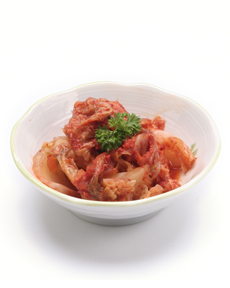Homemade Napa Cabbage Kimchi Recipe
|
We have a love for kimchi, Korean spicy preserved vegetables. We found ourselves buying many small packets of kimchi for $3.99 a pop. Then the light bulb turned on: These ingredients are very inexpensive and the finished product a long shelf life. Make it yourself! It’s easy, although time consuming; but we love making double and triple batches at a time.
Kimchi is a very healthful food, low in calories, high in fiber and bursting with vitamins and minerals. Variously spelled kimchee, kim chee or gimchi, it is the national dish of Korea. The name has origins in Korean or Chinese words referring to vegetables soaked in salted water. Historians believe that kimchi was first made by Koreans living in Manchuria, to preserve the vitamins and minerals in vegetables for the long winters. Kimchi can be served as a condiment, a side or in recipes that vary from kimchi stew or soup to kimchi pancakes and fried rice. |
A delicious side of kimchi. Photo courtesy Bento.com.sg. |
|
|
We like it on a burger, hot dog or sandwich, with scrambled eggs, as a side with grilled meats and as a low-calorie spicy/tangy snack. Kimchi is the Korean analogy to sauerkraut, another fermented cabbage dish; but it has much more complexity of flavor and texture. There are many different recipes for kimchi. The first step is to select the principal vegetable—typically cucumber, Napa cabbage (Chinese cabbage), radish or scallion. Then, add other fruits and vegetables, including the aforementioned and Asian pear. The sauce can be adjusted to your individual preferences and access to ingredients such as Korean fish sauce, crab fish sauce and salted shrimp. Kimchi is a “signature dish”: Each person can add his or her favorite ingredients to create a vibrant recipe. Don’t hesitate to add “American“ vegetables, such as bell pepper and carrots. Just keep the slices thin. This recipe is from one by John Ryan on LoveWithFood.com. This recipe makes 6 servings. Ingredients |
||
 Napa cabbage, also called Chinese cabbage. Photo courtesy LaurelOnHealthFood.com. |
Preparation
In earlier times, kimchi was often fermented in jars buried underground for months. Today, a few days in a dark corner, plus a week in the fridge, does the trick. 1. REMOVE the outer leaves of the cabbage if they are not fresh-looking. Trim the edges of the cabbage and separate the leaves. Reserve 4 leaves; chop the remainder of the cabbage into quarters, lengthwise. 2. PLACE water and salt in a large bowl, skillet or other container, stirring to combine. Soak the cabbage leaves for 6-8 hours (we do it overnight). 3. REMOVE the cabbage but reserve the salted water. Rinse the cabbage in cold water; shake, then wring out the excess water and move to paper towels to dry. 4. SLICE the daikon into matchsticks and chop the mustard greens. 5. COMBINE the ginger garlic paste and chili powder in a large bowl; make a paste by slowly adding 1/2 cup of water and whisking thoroughly. |
|
|
6. BLEND daikon, scallions and mustard greens into the paste. Wear gloves and toss with your hands. Then add the cabbage and finish blending the kimchi. 7. PLACE one of the reserved cabbage leaves on a plate or other surface; top with a few spoonfuls of kimchi. Repeat the process for all 4 leaves, making a stack of layers. 8. LIFT the layers into the jar and pack them tightly. Add any additional kimchi to the top. 9. POUR the reserved salt water into the jar until it reaches the brim. Tightly cap the jar. 10. FERMENT at room temperature for 3 days in a dark place; then place the jar in the refrigerator for 7 more days. Finally, you’re ready to enjoy the fruits (actually, vegetables) of your labors. The kimchi will continue to ferment in the jar; keep it in the fridge. Any bubbles you observe are natural fermentation. |
||



